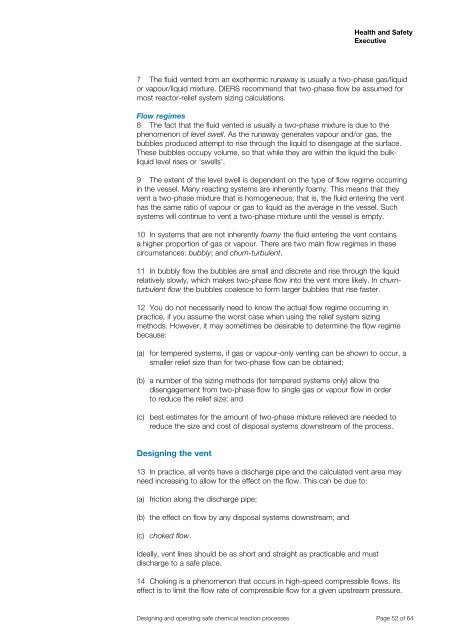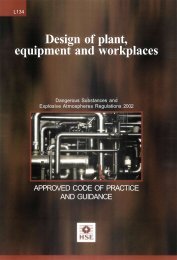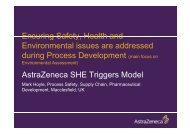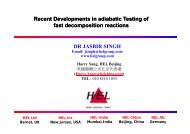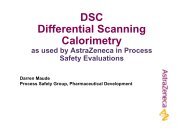Designing and operating safe chemical reaction processes HSG143
Designing and operating safe chemical reaction processes HSG143
Designing and operating safe chemical reaction processes HSG143
You also want an ePaper? Increase the reach of your titles
YUMPU automatically turns print PDFs into web optimized ePapers that Google loves.
Health <strong>and</strong> SafetyExecutive7 The fluid vented from an exothermic runaway is usually a two-phase gas/liquidor vapour/liquid mixture. DIERS recommend that two-phase flow be assumed formost reactor-relief system sizing calculations.Flow regimes8 The fact that the fluid vented is usually a two-phase mixture is due to thephenomenon of level swell. As the runaway generates vapour <strong>and</strong>/or gas, thebubbles produced attempt to rise through the liquid to disengage at the surface.These bubbles occupy volume, so that while they are within the liquid the bulkliquidlevel rises or ‘swells’.9 The extent of the level swell is dependent on the type of flow regime occurringin the vessel. Many reacting systems are inherently foamy. This means that theyvent a two-phase mixture that is homogeneous, that is, the fluid entering the venthas the same ratio of vapour or gas to liquid as the average in the vessel. Suchsystems will continue to vent a two-phase mixture until the vessel is empty.10 In systems that are not inherently foamy the fluid entering the vent containsa higher proportion of gas or vapour. There are two main flow regimes in thesecircumstances: bubbly; <strong>and</strong> churn-turbulent.11 In bubbly flow the bubbles are small <strong>and</strong> discrete <strong>and</strong> rise through the liquidrelatively slowly, which makes two-phase flow into the vent more likely. In churnturbulentflow the bubbles coalesce to form larger bubbles that rise faster.12 You do not necessarily need to know the actual flow regime occurring inpractice, if you assume the worst case when using the relief system sizingmethods. However, it may sometimes be desirable to determine the flow regimebecause:(a) for tempered systems, if gas or vapour-only venting can be shown to occur, asmaller relief size than for two-phase flow can be obtained;(b) a number of the sizing methods (for tempered systems only) allow thedisengagement from two-phase flow to single gas or vapour flow in orderto reduce the relief size; <strong>and</strong>(c) best estimates for the amount of two-phase mixture relieved are needed toreduce the size <strong>and</strong> cost of disposal systems downstream of the process.<strong>Designing</strong> the vent13 In practice, all vents have a discharge pipe <strong>and</strong> the calculated vent area mayneed increasing to allow for the effect on the flow. This can be due to:(a) friction along the discharge pipe;(b) the effect on flow by any disposal systems downstream; <strong>and</strong>(c) choked flow.Ideally, vent lines should be as short <strong>and</strong> straight as practicable <strong>and</strong> mustdischarge to a <strong>safe</strong> place.14 Choking is a phenomenon that occurs in high-speed compressible flows. Itseffect is to limit the flow rate of compressible flow for a given upstream pressure.<strong>Designing</strong> <strong>and</strong> <strong>operating</strong> <strong>safe</strong> <strong>chemical</strong> <strong>reaction</strong> <strong>processes</strong> Page 52 of 64


